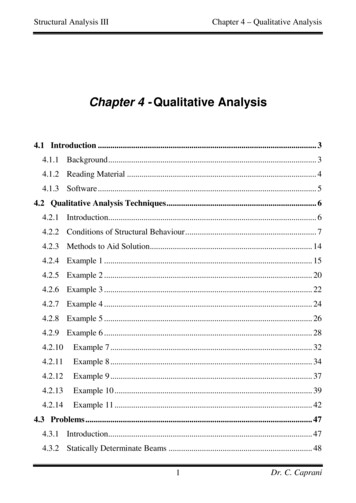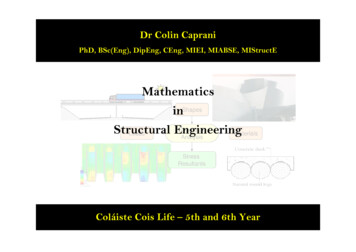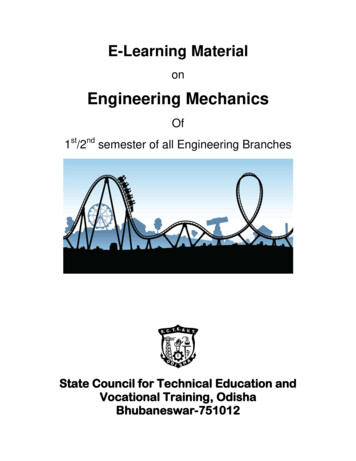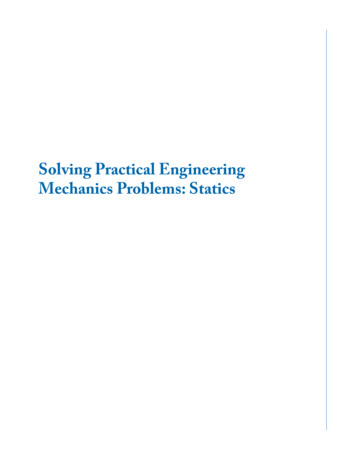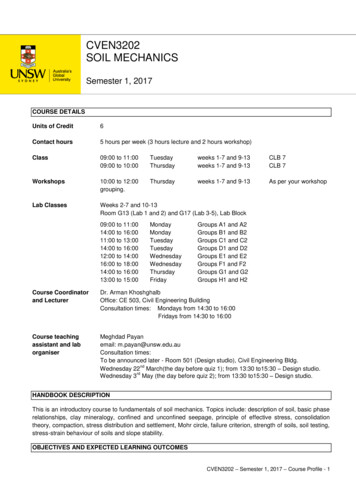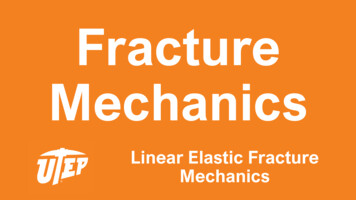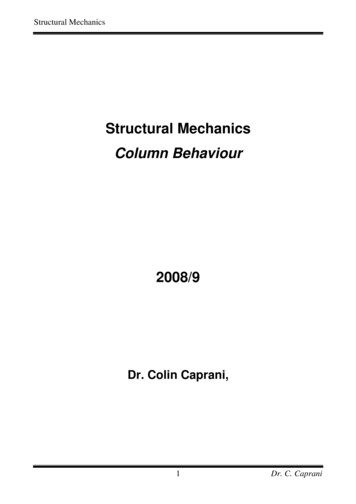
Transcription
Structural MechanicsStructural MechanicsColumn Behaviour2008/9Dr. Colin Caprani,1Dr. C. Caprani
Structural MechanicsContents1.2.3.4.Introduction . 31.1Background. 31.2Stability of Equilibrium . 4Buckling Solutions. 62.1Introduction. 62.2Pinned-Pinned Column. 72.3Column with Initial Displacements . 182.4The Effective Length of Columns . 30Column Design. 323.1Background to BS5950. 323.2Column Design Examples . 38Appendix . 474.1Solutions to Differential Equations . 474.2Code Extracts. 514.3Past Exam Questions . 622Dr. C. Caprani
Structural Mechanics1. Introduction1.1BackgroundIn the linear elastic analysis of structures, we have assumed that compressionmembers are limited in load capacity in the same way that tension members are, byensuring the yield stress of the material is not exceeded. However, as can easily bechecked with a ruler, compression members often fail long before the material yieldsdue to buckling. So our problem is to identify reduced stress limits that should applyfor compression members so that buckling does not occur.The first person to study this problem was Euler (‘oil-er’) as a means to demonstratehis ability to solve differential equations. Some of the important results in bucklingretain his name.Leonhard Euler (1707 – 1783)3Dr. C. Caprani
Structural Mechanics1.2Stability of EquilibriumA structure will be in an initial equilibrium position. The stability of its equilibriumcan be assessed by examining the structure’s behaviour in an adjacent position. Thereare three states: Stable equilibrium: the structure tends to return to its initial position. This isthe best situation to have structures in. Neutral (or critical) equilibrium: the structure moves to a displacedconfiguration and remains in that position. This does not make for goodstructure. Unstable equilibrium: any movement from the initial position causes furthermovement resulting in a ‘runaway’ failure of the structure.4Dr. C. Caprani
Structural MechanicsIn relation to columns, the stability of equilibrium takes the form: Stable: deflections to not result in extra bending moments, and hence extradeflections. Critical P Pcr : the load is at a critical value where the column remains in anydisplaced position. Unstable P Pcr : the load is greater than the critical load and so divergentdisplacements occur, leading to failure.These situations look like this:5Dr. C. Caprani
Structural Mechanics2. Buckling Solutions2.1IntroductionA perfect column (perfectly straight) is one which is perfectly straight and so carriesaxial load up to the yield stress of the material. Since in reality columns are notperfectly straight, buckling occurs:In our solutions for buckling, we will find that both the perfectly straight and buckledprofiles are both possible theoretically. However, since it is the real behaviour that isof interest, we will focus on the buckled solutions.6Dr. C. Caprani
Structural Mechanics2.2Pinned-Pinned ColumnFormulationFirstly, consider the buckled configuration of a pin-ended column and draw a freebody diagram of part of the column:From this we see:M Py7Dr. C. Caprani
Structural MechanicsSo for equilibrium:M Py 0We know from Euler-Bernoulli bending theory that:d2yM EI 2dxAnd so we have:EId2y Py 0dx 2(1)Dividing across by EI gives:d2y P y 0dx 2 EIIf we make the substitution:k2 PEI(2)We then have:d2y k2y 02dx8(3)Dr. C. Caprani
Structural MechanicsThis is a second-order linear homogenous differential equation in y. We seek asolution for y which will be some function of x. The Appendix shows that the generalsolution to this equation is:y A cos kx B sin kx(4)where A and B are constants to be evaluated from the boundary conditions of theproblem.9Dr. C. Caprani
Structural MechanicsRelevant SolutionTo get the particular solution to our problem, we know that we have no deflection atthe pinned end, that is:At x 0, y 0Substituting this into equation (4):0 A cos k 0 B sin k 0Since cos ( 0 ) 1 and sin ( 0 ) 0 , we have:0 A (1) B ( 0 )A 0Thus equation (4) becomes:y B sin kx(5)Using the second boundary condition, at x L, y 0 , we have:0 B sin kL(6)There are two possibilities now. The first is B 0 which makes y 0 by equation (5). This means that a possible solution is for no buckling to occur, in other words, theperfect column. Since we know that this is highly unlikely, and that buckling doesn’toccur, we must consider the other possibility from equation (6):10Dr. C. Caprani
Structural Mechanicssin kL 0(7)We know that this only happens at values of:kL 0, π , 2π ,3π ,. nπwhere n 0,1,2,3,. . Therefore we have:k nπL(8)So from equation (2) we have:P n 2π 2 2k EIL2And so the critical loads at which the column buckles are:Pcr n 2π 2 EIL2(9)Further, by using equation (8) in equation (5) the buckled shape is got as:y B sin11nπxL(10)Dr. C. Caprani
Structural MechanicsEuler Buckling LoadSince we are interested in the lowest load that the column will buckle at, we use thevalue n 1 to find the Euler Buckling Load, PE , as:PE π 2 EI(11)L2And we also find the displaced shape from equation (10) as:y B sinπLx(12)This defines a half sine-wave curve as being the buckled shape of the column. Noticethat we have no information about B, the amplitude of the displacement. This isbecause the column is in neutral equilibrium at PE and will be in equilibrium at anydisplacement amount.12Dr. C. Caprani
Structural MechanicsOther Buckling ModesIn general we can see that the column can buckle in the shapes:n01CriticalLoadInfinitePcr PE π 2 EIL2ModeShapey 0y B sinπLx23 4π 2 EIL29π 2 EIL2n 2π 2 EIL2B sin2πxLB sin3πxLB sinnπxLPlot13Dr. C. Caprani
Structural MechanicsHowever, to achieve these other buckling loads, the lower modes must be preventedfrom occurring by lateral restraints:14Dr. C. Caprani
Structural MechanicsCritical StressFor design, we are interested in the stress that the material undergoes at the time ofbuckling – the critical stress, σ cr :σ cr PE π 2 EI 2ALA(13)Looking at the factor I A , we see that it is a property of the shape of the crosssection, and is in units of [ length ]4[length ] [length ] . Therefore, we define a new22geometric property, r, called the Radius of Gyration as:IAr (14)And so r has units of length. The radius of gyration can be thought of as a distancefrom the centroid at which the area of the cross section is concentrated for calculatingthe second moment of area, I, since by (14),I Ar 2(15)The critical stress can now be expressed as:σ cr π 2 Er 2L2And we can see that the dimensional properties of the column are summed up by thefactor r 2 L2 , which represents a ratio of r to L. Thus we define the SlendernessRatio, λ , as:15Dr. C. Caprani
Structural Mechanicsλ Lr(16)Finally then, we have the equation for critical stress as:π 2Eσ cr 2λ(17)A plot of the critical stress against slenderness is called a strut curve and looks like:16Dr. C. Caprani
Structural MechanicsAs can be seen, at low slendernesses (that is short stocky columns), the critical stress(to cause bucking) reaches very high values. Since the maximum stress in thematerial is the yield stress, me must cap the curve at σ y .Finally, notice that typical experimental results fall below the Euler strut curve. Thisis because the theory examined so far is for perfectly straight columns that havesomehow begun to buckle. In real columns there will be some initial imperfectionswhich have the effect of reducing the strength of the column. These initialimperfections can be represented by an initial displacement curve.17Dr. C. Caprani
Structural Mechanics2.3Column with Initial DisplacementsProblem FormulationThe imperfections in the manufacture of real columns mean that an initialdisplacement curve exists in the column, prior to loading. Since any curve can berepresented by a Fourier series expansion, we will approximate the initial displacedshape by the first term of a Fourier series – a sine curve, the equation of which is:y0 ( x ) a sinπxL(18)where, at the midpoint of the column, the initial displacement is a.18Dr. C. Caprani
Structural MechanicsConsidering a free-body diagram as before:gives the equilibrium equation as:d2yEI 2 P ( y y0 ) 0dxThus we have:d2y PPy y0 0 2dxEIEIUsing equation (2) gives:19Dr. C. Caprani
Structural Mechanicsd2y k 2 y k 2 y0 02dxAnd so using equation (18) we haved2yπx22kyka sindx 2L(19)This is a non-homogenous second order differential equation.20Dr. C. Caprani
Structural MechanicsSolutionThe solution to non-homogenous differential equations is made up of two parts: The complimentary solution (denoted yC ): this is the solution to thecorresponding homogenous equation. That is, the solution when the right handside is zero. We have this from before as equation (4):yC A cos kx B sin kx (20)The particular solution (denoted yP ): for the function on the right hand side,the solution is verified in the Appendix as:yP k 2asinπxL π k 2 L k 2aπx 2sinπL k22L2(21)Thus the total solution is:y yC yP A cos kx B sin kx k 2aπ22L k2sinπx(22)LTo find the constants, we know that for the pinned-pinned column, y 0 at x 0 :21Dr. C. Caprani
Structural Mechanicsy ( 0 ) A cos k ( 0 ) B sin k ( 0 ) k 2aπ2L2 ksin2πL( 0)0 AAlso, y 0 at x L , giving:y ( L ) B sin k ( L ) k 2aπ2L2 ksin2πL( L)0 B sin kLAlthough this is the same equation as found for the perfectly straight column, wemust consider the implications. If B 0 then sin kL 0 and so kL π as before. Thisyields k π L , or k 2 π 2 L . Substituting this into equation (22) means that the2third term is infinite and so the deflection is infinite. Since this is impossible for astable column with P Pcr , we conclude that B 0 and we are left with:y k 2aπ2L2 ksin2πxL(23)This equation represents the deflections of the column caused by the loading. Thetotal deflection will be that caused by the loading, in addition to the initialimperfection deflection curve:ytot y y0And so:22Dr. C. Caprani
Structural Mechanicsytot k2π22La sin k2πxL a sinπxLSolving out, and dropping the tot subscript on y gives:: πxk2y 2 21asin 2L π L k And so: π 2 L2 πxy 2 2a sin2 L π L k (24)Now, using the expression for PE (equation (11)), we have:π2L2 PEEIAnd with the expression for k 2 (equation (2)), equation (24) becomes:y PE EIπxa sinPE EI P EILAnd so we have: P πxy E a sinL PE P 23(25)Dr. C. Caprani
Structural MechanicsThe term in brackets thus amplifies the initial deflection, depending on how close weare to the critical buckling load. A plot of load against deflection shows:24Dr. C. Caprani
Structural MechanicsMaximum Stress ConsiderationAt the mid-height of the column, the deflection will be largest, and thus so will thebending moment. The deflection at the mid-height is got from equation (25), withx L 2:π L L P y E a sin L 2 2 PE P P E a PE P We can equally interpret this equation in terms of stresses by dividing each of the Psby A: L σE y a2σσ E (26)where σ E is the stress associated with the critical Euler load (equation (13)).Consider again the free-body diagram of the column from mid-height to pin. Thereare two sources of stress:1. The stresses due to the moment alone are:σ Moment MzIwhere z is the distance from the neutral axis of the fibre under consideration.25Dr. C. Caprani
Structural Mechanics2. The stresses due to the axial force are:σ Axial PAThus the stresses at any point are given by:σ P Mz AI(27)Superposition of the stress diagrams shows this:The maximum stress is on the outside face and is thus:σ max P Mc AI(28)where c is the distance from the neutral axis to the inside face of the column.26Dr. C. Caprani
Structural MechanicsNext, into equation (28), we introduce the relevant properties of equation (15) and thefact that M Py ( L 2 ) yields:σ max σ Pcy ( L 2 )Ar 2But, from equation (26) we know the displacement at mid height, y ( L 2 ) :σ max σ Pc σ E aAr 2 σ E σ At failure the maximum stress is the yield stress, σ y . The stress associated with theload P when this occurs is σ cr . Hence the governing equation becomes:σ y σ cr σ crc σE ar 2 σ E σ cr Giving: σ y σ cr 1 ac σ E r 2 σ E σ cr (29)We are looking to find the value of σ cr that solves this equation. At the loadcorresponding to σ cr failure occurs. As can be seen, this failure stress is a function ofthe section (through r and c) and the initial imperfection, a, as well as the usual Eulerbuckling load for the column (through σ E ).27Dr. C. Caprani
Structural MechanicsCritical Stress for BucklingTo solve equation (29) for σ cr we proceed as follows: ac σ E 2 r σ E σ cr σ y r 2 (σ E σ cr ) σ cr r 2 (σ E σ cr ) acσ crσ Eσ y σ cr 1 σ yσ E r 2 σ yσ cr r 2 σ crσ E r 2 σ crσ cr r 2 acσ crσ Eσ yσ E r 2 σ yσ cr r 2 σ crσ E r 2 σ crσ cr r 2 acσ crσ E 0σ cr2 ( r 2 ) σ cr ( σ y r 2 σ E r 2 acσ E ) σ yσ E r 2 0 σ cr2 σ cr σ y σ E ac σ E σ yσ E 0r2 We call the parameter that accounts for the initial imperfections called the PerryFactor:η acr2(30)And this gives:σ cr2 σ cr σ y σ E (1 η ) σ yσ E 0(31)This is a quadratic equation in σ cr and so is solved by the usual: b b 2 4acx 2awhere:28Dr. C. Caprani
Structural Mechanicsa 1b σ y σ E (1 η ) c σ yσ EAnd this gives:σ cr 2σ y σ E (1 η ) σ y σ E (1 η ) 22 σσ y E 0.5(32)Notice that we have chosen the lower root of the two possible solutions.Equation (32) is called the Perry-Robertson formula and it gives the buckling stressin terms of the yield stress and initial imperfections of the column, as well as its Eulerbuckling load.It is useful to introduce the following:φ σ y σ E (1 η )2(33)And so the Perry-Robertson formula (equation (32)) becomes:σ cr φ φ 2 σ yσ E29(34)Dr. C. Caprani
Structural Mechanics2.4The Effective Length of ColumnsSo far we have only considered pinned-end columns but clearly other end conditionsare possible. Analysis of the buckling loads for such columns can be carried out alongthe same lines as for pinned-end columns. However, a significant advantage can begot by remembering that a point of contraflexure (zero moment) behaves as a pin(zero moment). The distance between points of contraflexure can be considered as apin-pin column, but with a smaller length than the overall column. We call this lengththe effective length, LE . Analysis then proceeds as for pinned-end columns, butusing the effective, rather than actual, length.The effective lengths of some typical columns are:Non-Sway ModesPin-PinFix-Pin30Fix-FixDr. C. Caprani
Structural MechanicsSway ModesFix-fixFix-rollerCantilever (fix-free)Notice from the above that the locations of the points of contraflexure do not have tobe and can be located outside the column. That is, the column is buckling over anotional length of LE .The effective length only affects the slenderness and so the general case forslenderness is:λ LEr31(35)Dr. C. Caprani
Structural Mechanics3. Column Design3.1Background to BS5950Initial ImperfectionsRobertson performed many tests on struts to arrive at a suitable value for the initialimperfections in the approach outlined in the previous section. He suggested:η 0.003λ(36)where λ is the slenderness of the column, given by equation (16). More recently, theinitial imperfection has been taken as: λ η 0.3 100 2(37)The idea of linking the initial imperfections to the slenderness is intuitively appealing– the slimmer a column is, the more likely it is to have imperfections.The steel design code BS5950 is based on the following:η a ( λ λ0 )1000(38)In which: a is the Robertson constant (and is not the same as the a we had for thedeflection of the column previously); λ0 is called the limiting slenderness as is given by:32Dr. C. Caprani
Structural Mechanicsπ 2Eλ0 0.2σy(39)By rearranging equation (17) it can be seen that this is:λ0 0.2λcrwhere λcr is the slenderness at which the Euler stress reaches the yield stress of thematerial.As can be seen, the higher the value of a, the more initial imperfection is accountedfor and the compressive strength reduces as a result.33Dr. C. Caprani
Structural MechanicsCode ExpressionsIn BS5950, the Perry-Robertson formula is given in a slightly different form to thatpresented in equation (34). To get the code expression, we multiply top and bottom ofequation (34) by φ φ 2 σ yσ E to get: φ φ 2 σ yσ E φ φ 2 σ yσ E σ cr 2φ φ σ yσ EAnd multiplying out gives:σ cr φ 2 φ 2 σ yσ Eφ φ 2 σ yσ Eσ yσ Eφ φ 2 σ yσ ELastly, to get the code expression, we must use the code notation which is:pC σ crpy σ ypE σ ESo finally we have the expression in Appendix C of BS5950:pc pE p yφ φ 2 pE p y34(40)Dr. C. Caprani
Structural MechanicsStrut CurvesBS5950 provides four values of the Robertson constant that may be used in design. Italso specifies what value of a to use for the various types of steel section and the axisabout which buckling may occur. The values are: a 2.0 - strut curve (a); a 3.5 - strut curve (b); a 5.5 - strut curve (c); a 8.0 - strut curve (d).Given the initial imperfection model of equation (38) as well as the Perry-Roberstonformula, equation (40), we can plot the four strut curves used in the code:400Eulera 2Compression Strength (N/mm2)350a 3.5300a 5.5a ness λAlso shown in this plot are the limiting slenderness, and the critical slenderness,discussed in relation to equation (38).35Dr. C. Caprani
Structural MechanicsThe code provides four tables (Table 24(a) to 24(d)) – corresponding to the strutcurves, which are formatted as follows:pyλ15.350225.275.Values of pc from equation (40).Table 23 of the code allocates the strut curves to different section types and axes:36Dr. C. Caprani
Structural MechanicsEffective LengthsTable 22 of the code specifies the appropriate effective lengths for columns withdifferent end conditions, end conditions that occur in practice. The meanings of thephrases in Table 22 are as follows:TermDiagramEffectively held in position, notrestrained in direction.(pin)Effectively held in position,partially restrained in direction.(rotational spring)Effectively held in position andrestrained in direction.(fixed)Not held in position, andeffectively restrained in direction.(fixed with sway)Not held in position, partiallyrestrained in direction.(rotational spring with sway)Not held in position or restrainedin direction.(free)37Dr. C. Caprani
Structural Mechanics3.2Column Design ExamplesExample 1ProblemA 5.6 m high column consists of a 203 203 46 UC section. It is supported alongits x-axis and is pinned at both ends. Find the buckling load.SolutionFirstly, sketch the column:38Dr. C. Caprani
Structural MechanicsSince the column is supported along its x-x axis, it can only buckle about its y-y axis.The relevant section properties for a 203 203 46 UC are:Cross-Sectional Area58.8 cm2Yield stress275 N/mm2Modulus of Elasticity205 kN/mm2Radius of gyration about the y-y axis5.12 cmRobertson Constant for the y-y axis5.5Thus:λ 5600 109.6 11051.1From Table 23 we see that we are using strut curve (c) and so a 5.5 . Also,E 205 kN/mm 2 and p y 265 N/mm 2 from Table 9. Thus:The limiting slenderness (equation (39)) is:λ0 0.2π 2Epy 0.2π 2 205 103265 17.48The Perry Factor (equation (38)) is:η a ( λ λ0 ) 5.5 (110 17.48 ) 0.50910001000The Euler stress (equation (17) is:39Dr. C. Caprani
Structural MechanicspE π 2 E π 2 205 103 168 N/mm 222λ110The modifying stress (equation (33)) is:φ p y (η 1) pE2 265 ( 0.509 1)168 259 N/mm 22And so the compressive strength (equations (34)or (40)):pc pE p yφ φ pE p y2 168 265259 259 168 2652 108.6 N/mm 2Thus the buckling load is:P Ag pc 5880 108.6 640.4 kN103To check this, use Table 24(c), for λ 110 andp y 265 N/mm 2 gives:pc 108 N/mm 2 and so the capacity is 108 5880 103 635 kN , which is similar tothe previous calculation.40Dr. C. Caprani
Structural MechanicsExample 2ProblemFor the column of Example 1, the restraint along the x-x axis has to be removed.Determine the buckling capacity.SolutionAgain, sketch the column:41Dr. C. Caprani
Structural MechanicsSince the column can now buckle about both its x-x axis and y-y axis, we will need todetermine the buckling capacity of each axis. Of course the buckling capacity aboutthe y-y axis has already been determined from Example 1, so it remains to find thecapacity about the x-x axis. The relevant section properties are:Cross-Sectional Area58.8 cm2Yield stress275 N/mm2Modulus of Elasticity205 kN/mm2Radius of gyration about the x-x axis8.81 cmRobertson Constant for the x-x axis3.5Thus:λ 5600 63.688.1The limiting slenderness is the same as in Example 1 since E nor p y change:λ0 17.48The Perry Factor (equation (38)) is:η a ( λ λ0 ) 3.5 ( 63.6 17.48 ) 0.1610001000The Euler stress (equation (17) is:pE π 2 E π 2 205 103 500.8 N/mm 22263.6λ42Dr. C. Caprani
Structural MechanicsThe modifying stress (equation (33)) is:φ p y (η 1) pE 2265 ( 0.16 1) 500.8 423.3 N/mm 22And so the compressive strength (equations (34)or (40)):pc pE p yφ φ pE p y2 500.8 265423.3 423.3 500.8 2652 207.7 N/mm 2Thus the load to cause buckling about the x-x axis is:P Ag pc 5880 207.7 1221.5 kN103Check this value using Table 24.Since the buckling capacities are: x-x axis: P 1221.5 kN ; y-y axis P 640.4 kN ;the column will first buckle about the y-y axis and so its overall buckling capacity is:P 640.4 kN43Dr. C. Caprani
Structural MechanicsExample 3ProblemTo increase the capacity of the column of Example 2, the supports in the y-y axishave been changed to fixed-fixed. Determine the buckling capacity.SolutionAs always, sketch the column:44Dr. C. Caprani
Structural MechanicsWe know the buckling capacity about the x-x axis from Example 2, but since thesupport conditions for the y-y axis have changed, the buckling capacity about the y-yaxis changes. Again the relevant properties are:Cross-Sectional Area58.8 cm2Yield stress275 N/mm2Modulus of Elasticity205 kN/mm2Radius of gyration about the y-y axis5.12 cmRobertson Constant for the y-y axis5.5In this case, since the restraints are fixed-fixed, the effective length is:LE 0.7 L 0.7 5600 3920 mmThus the slenderness is:λ 3920 76.651.2The limiting slenderness is the same as before, λ0 17.48 . The Perry Factor(equation (38)) is:η a ( λ λ0 ) 5.5 ( 76.6 17.48 ) 0.3210001000The Euler stress (equation (17) is:π 2 E π 2 205 103pE 2 345.2 N/mm 22λ76.645Dr. C. Caprani
Structural MechanicsThe modifying stress (equation (33)) is:φ p y (η 1) pE 2265 ( 0.32 1) 345.2 361.2 N/mm 22And so the compressive strength (equations (34)or (40)):pc pE p yφ φ pE p y2 345.2 265361.2 361.2 345.2 2652 163.8 N/mm 2Thus the load to cause buckling about the y-y axis is thus:P Ag pc 5880 163.8 962.9 kN103Check this value using Table 24.Since the buckling capacities are: x-x axis: P 1221.5 kN - still as per Example 2; y-y axis P 962.9 kN - changed due to new support conditions;thus, the column will first buckle about the y-y axis and so its overall bucklingcapacity is:P 962.9 kNNotice that a change in support conditions has resulted in a nearly 50% increase incapacity.46Dr. C. Caprani
Structural Mechanics4. Appendix4.1Solutions to Differential EquationsThe Homogenous EquationTo find the solution of:d2y k2y 02dx(41)we try y eλ x (note that this λ has nothing to do with slenderness but is theconventional mathematical notation for this problem). Thus we have:d2y λ 2eλ x2dxdy λ eλ x ;dxSubstituting this into (41) gives:λ 2eλ x k 2eλ x 0And so we get the characteristic equation by dividing out eλ x :λ2 k2 0From which:λ k 2Or,47Dr. C. Caprani
Structural Mechanicsλ1 ik ;λ2 ikWhere i 1 . Since these are both solutions, they are both valid and the expressionfor y becomes:y A1eikx A2e ikx(42)In which A1 and A2 are constants to be determined from the initial conditions of theproblem. Introducing Euler’s equations:eikx cos kx i sin kxe ikx cos kx i sin kx(43)into (42) gives us:y A1 ( cos kx i sin kx ) A2 ( cos kx i sin kx )Collecting terms:y ( A1 A2 ) cos kx ( iA1 iA2 ) sin kxSince the coefficients of the trigonometric functions are constants we can just write:y A cos kx B sin kx(44)Which is the solution presented in equation (4).48Dr. C. Caprani
Structural MechanicsParticular Solution of Non-homogenous EquationWe seek here to show the particular solution to the problem:d2y k 2 y A sin λ x2dx(45)y B sin λ x(46)Is given by:From (46):d2y λ 2 B sin λ x2dxdy λ B cos λ x;dxSubstitution into (45) gives: λ 2 B sin λ x k 2 B sin λ x A sin λ x(47)Dividing out the common term: λ 2 B k 2 B A(48)And so:B A λ k 22(49)49Dr. C. Caprani
Structural MechanicsThus (46) becomes:y Asin λ x λ k 22(50)Looking at equation (19), we see that:A k 2 aλ πLAnd so the particular solution of equation (19) becomes:y k 2 a π k 2 L 2sin λ x(51)Which is given previously as equation (21).50Dr. C. Caprani
Structural Mechanics4.2Code Extracts51Dr. C. Caprani
Structural Mechanics52Dr. C. Caprani
Structural Mechanics53Dr. C. Caprani
Structural Mechanics54Dr. C. Caprani
Structural Mechanics55Dr. C. Caprani
Structural Mechanics56Dr. C. Caprani
Structural Mechanics57Dr. C. Caprani
Structural Mechanics58Dr. C. Caprani
Structural Mechanics59Dr. C. Caprani
Structural Mechanics60Dr. C. Caprani
Structural Mechanics61Dr. C. Caprani
Structural Mechanics4.3Past Exam QuestionsSemester 1 Paper 2007/8(a) Briefly explain how to calculate the second moment of area of a section comprised of simple shapes.(b) Describe what is meant by complimentary shear stresses.(c) Determine the maximum load w that can be sustained by the column BD shown in Fig. Q.4.The relevant section properties are given in Table Q4 and the Perry-Robertson formula is given.(3 marks)(4 marks)(18 marks)w kN/mBCPINNEDCONNECTIONB3m6m3mADD3m6mELEVATION X-X AXISELEVATION Y-Y AXISFIG. Q4Table Q4Relevant Section Properties for 152 152 23 UC29.2 cm2Cross-Sectional Area2Radius of gyration about the x-x axis6.54 cmYield stress275 N/mmRadius of gyration about the y-y axis3.70 cmModulus of Elasticity205 kN/mm2Robertson Constant for the x-x axis5.5Robertson Constant for the y-y axis5.5Perry-Robertson Strut Formula:pc pE p yφ φ 2 pE p ywhereφ p y (η 1) pE2;pE π 2E;λ2η a ( λ λ0 )1000;λ0 0.2π 2EpyIn which the symbols have their usual meanings.62Dr. C. Caprani
Structural Mechanics 5 Dr. C. Caprani In relation to columns, the stability of equilibrium takes the form: Stable: deflections to not result in extra bending moments, and hence extra deflections. Critical cr PP : the load is at a critical value where the column remains in any displaced position. Unstable cr PP : the load is greater than the critical load and so divergent

